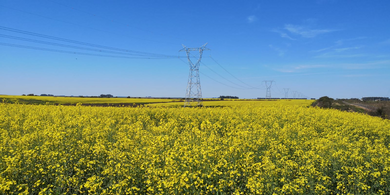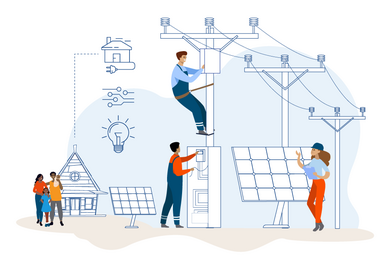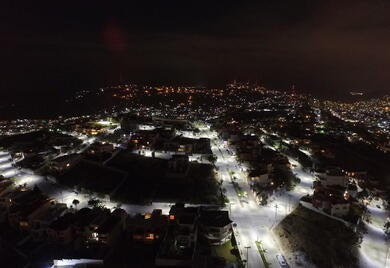
How to Promote Energy Efficiency in the Private Sector
Energy efficiency is critical for Latin America and the Caribbean, historically characterized by high energy consumption and low productivity. Lessons learned from promoting energy efficiency practices among firms can help guide strategies moving forward.

Green Transmission Lines: Key Asset for the Development of Renewables in the Region
You probably haven't heard yet about a great way to ensure the sustainability of the energy sector: green transmission lines. These lines contribute to decarbonize interconnected national grids and feature top notch social practices.

Can Solar Panels Be the Cellphones of the Future?
The tech revolution in solar energy, driving a significant drop in costs, is the best solution to the problem of connecting isolated communities to the power grid. These models, however, also provide a vision of a possible future with decentralized networks or even customers who not only consume energy but also produce and send it into the grid.

Can an entire city switch to LED lights?
Over the past few years, LEDs have become increasingly common, as they provide long-lasting performance for a fraction of the energy used by traditional lights. Think of the latest generation of LED TVs, modern car lights or even household light bulbs. Many LEDs today have an expected lifespan of over 20 years while using 80% less energy to produce the same amount of light. With savings like this, imagine switching over an entire city to LED lighting.

Energy Efficiency: A game changer for business & the environment
Energy efficiency is a simple concept. Do more with less. Channeled through a wide array of industries and organizational departments in Latin America and the Caribbean and elsewhere, a serious approach to energy efficiency has many winners - consumers, private firms and governments.

How to calculate the cost of generating electricity
When I attend energy conferences in Latin America and the Caribbean, whether as a panelist or attendee, I often hear questions such as: What type of energy is cheaper: thermoelectric or renewable energy? And what is the most competitive renewable technology: hydroelectric, solar, or wind? These are also the basic questions that regulatory entities ask when planning to expand their energy matrices. Investors also ask these questions when seeking opportunities for investment in the region. Comparing apples and oranges The answer is not so simple. We are talking about different technologies with different investment requirements, dissimilar service life, capacity factors and operational costs that vary based on the project type and location. The levelized cost of energy (LCOE) is a useful tool that can be used to consistently compare the costs of different types of technologies (solar, wind, natural gas, etc.). How to calculate the levelized cost of energy (LCOE) In simple terms, the LCOE consists of calculating the total average cost of building and operating an electrical power station and dividing it among the total energy to be generated over its entire service life. The National Renewable Energy Laboratory (NREL) has financial models available to the public that can be used to calculate the LCOE for solar and wind plants. The models contain variables such as the investment cost necessary to build the plant, the useful life of the power station, and annual operating and maintenance costs, among other variables. Performing a sensitivity analysis of these different variables allows us to determine which specific actions can be taken to reduce the levelized cost of electricity in a specific project. The conclusions may vary, from changing the equipment provider to reconsidering the project’s site. What information can be obtained from the LCOE? The first benefit is the ability to compare to make informed decisions. The LCOE tool also: Provides a break-even point: Its result, expressed in kilowatt hours (kWh), can also be considered the break-even point for an electrical power station, i.e. the minimum price at which it would have to sell electricity to neither gain nor lose. Yields interesting conclusions: Using the LCOE as a tool for a competitive measure among various sources of energy allows for obtaining diametrically different results, even within the same technology. For example, the LCOE in a country with ideal geography for mini-hydroelectric power stations (in terms of both investment cost and plant factors) could be much less than a run-of-river hydroelectric power station in a flat country with high labor costs. Measures competitiveness trends among different technologies over time. Thus, five years ago the levelized cost of solar plants could not compete with other sources of energy. Thanks to the drastic reduction in investment cost, solar plants now compete at the same level as other technologies in bidding for energy contracts. LCOE and other available tools IRENA, in its 2016 publication, analyzes levelized cost of renewable energy trends in Latin America and the Caribbean with revealing conclusions. Even though the cost of installing wind farms in the region is slightly higher than in more developed countries (such as India and China), the region’s higher level of wind resources makes it possible to achieve a higher capacity factor —the ratio between the actual energy generated during a given period and what would have been produced if the plant had been continuously operating at nominal power during that period— resulting in a comparatively similar LCOE. For example, in some areas of Brazil, the plant factor reached 50 percent. It should be emphasized that although the LCOE is widely used to compare unit costs among technologies, the methodology does have some limitations since its results are highly dependent on the scope and assumptions used. Nonetheless, there are various tools and technologies that seek to determine relative economic competitiveness among different technologies. These include the Levelized Avoided Cost of Energy (LACE), which measures the avoided cost of electricity of a new electrical power plant due to the displacement that the new infrastructure produces in the system. However, this will be the subject of a future blog entry. Subscribe to receive more content like this! [mc4wp_form]